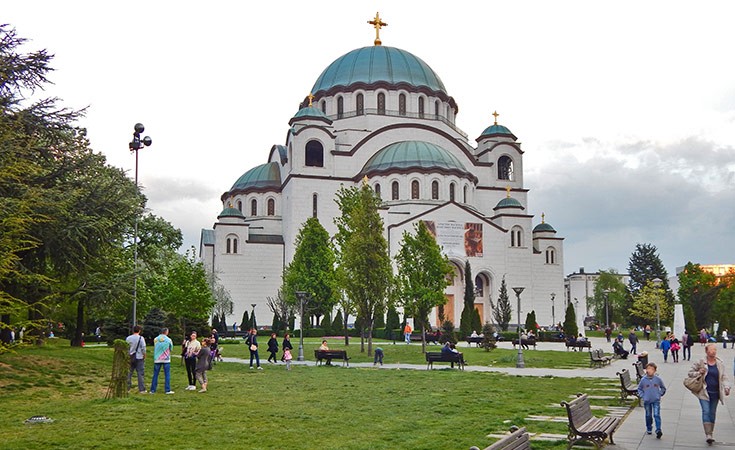
The Temple of Saint Sava is the largest Serbian Orthodox Temple and one of the largest Orthodox buildings in the world. It is a symbol of Serbian history and religion, the most impressive building of Belgrade and certainly a building of a very interesting story. No tourist should miss entering this incredible monument.
The temple is dedicated to Saint Sava, one of the most important saints in Serbian Religious calendar. He is celebrated as the patron saint of all schools and educational institutions.
Saint Sava
 Saint Sava or Rastko Nemanjic (1174-1236) was the youngest son of the Serbian prince Stefan Nemanja. Even though he received Zahumlje to govern during his youth, he was not as interested in ruling as he was in the religious matters. Therefore, he ran awayto the Mount Athos (a peninsula in nowadays Greece) where he became a monk and took the name Sava. He was a Serbian prince, a monk, a writer, a diplomat and the first archbishop of the independent Serbian Orthodox Church. The independence of Serbian Orthodox church gained in 1219 is considered his greatest achievement. He undertook several pilgrimages to the Holy Land of Palestine and on the last of these trips he died and was buried in Bulgaria. Two years later, with great effort his remains were transferred to Serbia where he found his final resting place in the monastery Milesevo. After 1389, Serbian state fell victim to the expansion of the Ottoman Empire on the Balkan Peninsula. Since the cult of Saint Sava was very strong among the local population, a Turkish officer Sinan pasha ordered Sava’s remains to be brought from Milesevo monastery to Belgrade and to be burned, according to the tradition, right where the temple of Saint Sava is located today.
Saint Sava or Rastko Nemanjic (1174-1236) was the youngest son of the Serbian prince Stefan Nemanja. Even though he received Zahumlje to govern during his youth, he was not as interested in ruling as he was in the religious matters. Therefore, he ran awayto the Mount Athos (a peninsula in nowadays Greece) where he became a monk and took the name Sava. He was a Serbian prince, a monk, a writer, a diplomat and the first archbishop of the independent Serbian Orthodox Church. The independence of Serbian Orthodox church gained in 1219 is considered his greatest achievement. He undertook several pilgrimages to the Holy Land of Palestine and on the last of these trips he died and was buried in Bulgaria. Two years later, with great effort his remains were transferred to Serbia where he found his final resting place in the monastery Milesevo. After 1389, Serbian state fell victim to the expansion of the Ottoman Empire on the Balkan Peninsula. Since the cult of Saint Sava was very strong among the local population, a Turkish officer Sinan pasha ordered Sava’s remains to be brought from Milesevo monastery to Belgrade and to be burned, according to the tradition, right where the temple of Saint Sava is located today.
Three hundred years after the Saint Sava’s remains were burned at stake (1895), a committee was formed with the aim of building a temple dedicated to this saint. The committee organized several contests in order to find the most appropriate architectural solutions. However, the war with Bulgaria (1912) and the First World War (1914-1918) delayed the construction of the temple. The final construction of the temple of Saint Sava started in 1935, only to be interrupted with the beginning of the Second World War. This war completely stopped any work on the building, the walls of which reached the height of 7 to 11 meters till this time. After the liberation of Belgrade by the Yugoslavian Army and the Red Army, due to the lack of political will, the continuation of works had to wait for a few decades. Only in 1985, the works continued, while most of the structural works were finalized by 1989. The temple got its façade in 2002, while most of the interior still waits on sufficient financial resources in order to be completed.
In the same yard of the temple of Saint Sava, there is also a church called the church of Saint Sava. This church was constructed partially with the materials of the temporary temple, which was demolished in order for the new one to be built.
Ticket prices for Saint Sava Temple in Belgrade
 The entrance is FREE of charge.
The entrance is FREE of charge.
Working hours of Saint Sava Temple in Belgrade
 From Monday to Friday working hours are: 07:00 – 20:00h.
From Monday to Friday working hours are: 07:00 – 20:00h.
Interesting facts